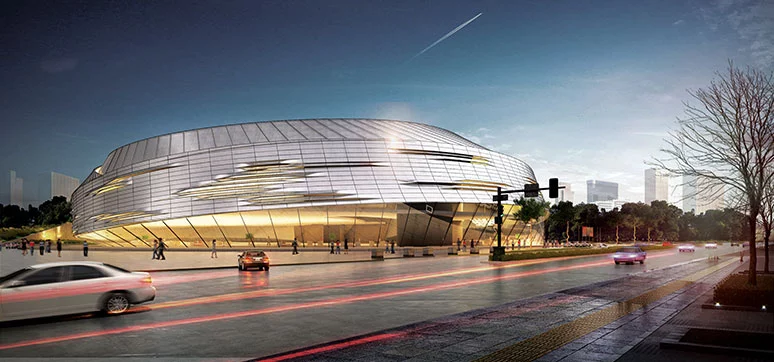No doubt, façades are the most important building element from both the user’s and the architect’s point of view. They are the most difficult to design too since the perception of iconic and technologically advanced facades is changing frequently. Designers are researching and experimenting with new and complex façade forms and patterns. The glass aluminium facades are bygones now as we see a lot more new materials in the market such as rusted iron panels, zinc, copper and steel, and even high-pressure laminates.
Along with the materials that furnish the look and feel of a building, technologies applied to facades are also changing. Leading-edge technologies play a crucial role in terms of sustainability and operational cost-effectiveness. Truly successful facades do far more than merely project an iconic image, they play a vital role in driving or transforming building performance, engaging with the external environment, significantly enhancing durability, and reducing energy consumption.
But how smart can a facade truly be? To what extent are technological developments transforming the facade performance? And do we have the tools and metrics in place to truly gauge and build these smart facades? This edition’s cover story throws light into all these aspects which would help build flawless ‘future facades’.
Façade in Perspective – Experts Envisage

In architecture and construction, nothing summarises the dual qualities of performance and appearance like the building façades. In alignment with these two key components of the building, notes Ar. Vivek Gupta, Principal Architect, Arvind Vivek & Associates, a façade must contribute positively to its performance while still ensuring an aesthetically pleasing form. Innovations in façade technology and building solutions are potential advancements in the green building movement, contributing to the creation of greener, healthier places for people.

Ar. Yatin Patel, Founder and Principal Designer, of DSP Design Associates, agrees with Ar. Gupta on the need for innovations in façade materials and technologies. “We can anticipate research to be aggressive, innovating on façade that responds to macro public elements as well – for example, transport/logistics,” says Patel.

Ar. Zubin Zainuddin and Ar. Krupa Zubin, Principal Architects, ZZ Architects points out that façades have to be more than just elevations skins on buildings. A lot of research is being done on harnessing the surface area of the façade to help in generating energy. The façade also has to ensure that the optimal lighting and
comfort are sealed within the building premise, considering the imperative role played by building façades in reducing the building’s energy consumption, improving natural lighting, and offering better airflow within the building.

Thrusting on the need for “Out of the Box” research and experimentation, Ash A. Parekh, Principal Architect, The Opus D’Sign Studio are hopeful that façades reacting to dynamic weather conditions and those using sustainable building materials will gain momentum. He is sure that the architect’s aesthetic vision and “excitement factor” as well as the everchanging customer requirement will drive the development of a “technoholistic” design. Initially, façades were formulated using two distinct strategies, namely technology, and market (or customer-driven).

Ar. Karl Wadia, Senior Associate, Architect Hafeez Contractor has no doubt that the façades of the future are going to react to the climatic condition around them – façade that will change during the day and night; façade that will let the natural air in the early hours of the morning and close themselves down by late morning; façade which will protect the building from the sharp westerly sun and then open up towards the evening to bring in more light and natural air, are futuristic.
Ar. Vivek Bhole, Principal architect, Vivek Bhole Architects Pvt. Ltd says that in the past, the façade methodology remained complementary to the structural systems along with other factors like climate and aesthetical preferences. With the inception of framed structures, precast and prefabricated façades are going to define the future façades.
Ar. Gupta too agrees with Ar. Bhole is sure that prefabrication and modularisation strategies are being adopted as mainstream construction practices, which will ultimately bring great change to the building design. Along with it, robotics, digital printing, augmented virtual reality, artificial intelligence and other advanced digital processes will shape the future of construction and the building skin adds Gupta.

According to Piyush Srivastava, National Façade Manager, Schueco India Private Limited, the future of façade includes an increase in opacity and energy efficiency, and widely accepted aluminium system’s façade product rather than a bespoke system which decide the future construction. Also, new materials are flooding the marketplace at an exponential rate. However, incorporating these materials into existing systems often poses a unique set of issues: performance, tolerance, compatibility, warranty, and waterproofing.
Building façades of the future will develop in two different trajectories.
-

Ar.Dhurghai Kumaran, Director – Studio FHD Group, Hyderabad Human-centric: Façades could begin to mimic human skin in its property to breathe, allow necessary daylight, and take sustainability to an all-new level. Sustainability will hold the key to future façades.
- Technology-driven: Façades could become digital platforms for presenting identity. It opens façades as a dynamic element rather than static cover. We are already seeing LCD screens becoming façades in commercial buildings.(Dhurghai Kumaran, Director – Studio, FHD Group, Hyderabad)
“The uPVC Windows’ Growth Would be from 20 to 25 % in the Coming Years”
India is experiencing a construction boom in terms of the growing economy and it is accelerating the growth of the window & façade industry. Today, the windows & doors segment is standing approximately at 2 billion Euros which makes it a good sizable market. With mass and low-cost housings coming into the picture, the windows from good players at affordable prices with decent quality will have demand in the market. I believe that the windows & facades industry is going to grow manifolds.

India has the best international architects and they can replicate the best façade around the world in Indian buildings. Now in India, a lot of new materials are coming into the construction market. Performance windows are the trend and the best available options for such windows are uPVC as well as aluminium windows. Glass is evolving day by day and it will play a very important part in the facade systems in the coming years.
I see a lot of changes happening in the window industry like double glazing. With increased urbanization and the purchasing power of the population, people will go for quality materials. I foresee that the uPVC windows’ growth will be from 20 to 25 per cent in the coming 3-4 years. The aluminium windows would transform from non-thermal to thermal and the growth rate will be the same as that of uPVC windows (20-25 per cent).
(Farid Khan, Director, and CEO, profine India Window Technology Pvt. Ltd.)
It is imperative that, in the future, buildings will become smarter, façades will become more complex, dynamic, and interactive, making the building/user interface far more intimate and individualized, predicts Gupta. While it can be challenging even to get users to adjust blinds in response to changing exterior lighting conditions, emerging automated technologies Accel House at Thane, designed by ZZ Hospital at Amanora Park Town by The Opus D’Sign Studio Architects will tune basic workspace conditions to each user, Gupta is optimistic. At the same time, users will be able to interact with individual workspace conditions very similar to how they engage with their smart devices, through graphics, motion, and voice which will be integrated into those very devices.
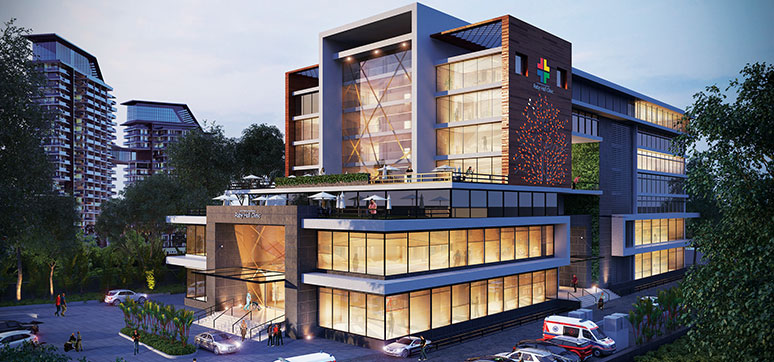
We have seen passive and active façades in contemporary architecture. Parekh believes that we will see emergence and acceleration in the use of cognitive or intellectual building façades. The intellectual façade will respond to internal and external conditions, seamlessly coordinating with the building’s MEP systems to create a network of cognitive solutions. Variables such as non-predictive weather conditions and micro-climate influences by adjacent structures will create a “pro-active” building skin.
The bio-climaticfaçade design is a raging trend internationally that caters to the seasons of the local area controlling the summer sun, and winter chills while also making the interiors and exteriors thermally and visually well-performing, says Ar. Patel. Stainless steel has been yet another material choice in the case of bioclimatic projects globally, given its durability and low maintenance costs.
Besides technology, materials like glass, concrete, etc., used for the building skin are an integral yet singular aspect of the façade design points out Gupta. Durable, malleable, and scalable materials like copper, concrete, etc., are the choice for architects who innovate in designing functional cladding.
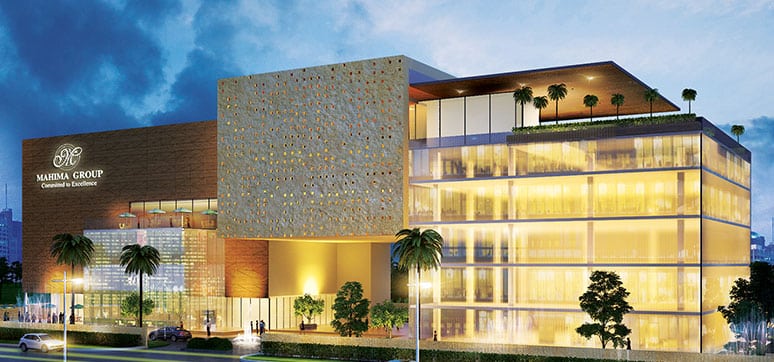
Earth’s climate, health and safety, lifestyle, and rapid urbanization will result in super tall and smart buildings. The buildings will have complex but efficient structural systems like diagrids, exoskeletons, space trusses, etc. and façades will follow the process, says Ar. Bhole. In the next few decades, we will witness multiple options and experiments in automated or electronically controlled dynamic façades with dynamic property changing glass for improved energy efficiency, indoor comfort, and overall environmental quality, he adds.
Key Characters of High-Performance Façades
A high-performance façade is a façade that not just envelopes your building, but works with your building to give you optimum daylight, comfort, no glare, and reduction of heat gain, explains Ar. Karl Wadia. An optimum high-performance façade is always going to be one that shields you from the external harsh atmosphere, while at the same time not demanding you to turn on many high levels of air conditioning.
High-performance façades effectively ensure a better working environment and can add immense value to the end-user, adds Ar. Zainuddin and Ar.Bhole. It gives flexibility not only in design and design expression along with the execution of façades in the factory and on-site but also facilitates cleaning, maintenance and replacements subsequently. Ar. Krupa Zubin gives an example – double-skin façade buildings were first built during the first energy crisis as an attempt to improve building performance. The recent resurgence of efficient building design has renewed interest in this concept, she observes. Since the Green Building Council offered reward points for a reduction in energy consumption, this strategy has been used to optimize the energy performance of buildings.
Ar. Yatin Patel and Ar. Parekh agrees that façade systems should address the management of glare and light, solar gains, acoustical considerations, ventilation, energy harvesting, and more. Integration between the façade as a building skin being elevated to other building systems adds to the intelligence in building management technology. Façades that integrate electrical and plumbing services through closed-cavity systems or automated shading devices driven by sensory controls for electric and mechanical applications efficaciously widen the performance spectrum for building skin. also needs to comply with a host of industry concerns, namely, Capex cost, maintenance, and constructability. It is critical that all the building skin components work seamlessly together to create a technically coherent solution, giving the designer a unique opportunity to display their concept, form, functionality, and technological prowess.
Kumaran too opines that in the Indian market, low-cost solutions in high-performance façades will be key criteria. High performance, in terms of energy efficiency and sustainability, will be the key driver in façade technology. He agrees that in addition to modularity in façade technology, ease of production, installation, and maintenance are essential characteristics of a high-performance façade. In terms of key façade performance, it should be pre-tested and certified, especially against structural, air permeability, water tightness, and thermal, acoustic, and seismic if required, adds Srivastava.
According to Ar. Gupta, passive design strategies possess fundamental advantages in developing low-energy buildings.
Two major types of façades exist curtain walls and double façades. Both can contribute to a more optimal thermal comfort, says Gupta. The rising trend, however, is adaptive façades – an envelope that uses flexibility to actively regulate indoor conditions and helps in increasing the energy efficiency of a building. Extrinsic control of these adaptive systems possesses the quality to combine (central) automated strategies with local control and individual user needs. Adaptive systems are most suited for the moderate climate zone, as a consequence of the seasonal variation between the need for heating and the protection against overheating.
Advancement in Façade Technology and Materials
Façade methodology has always remained complementary to the structural systems along with other factors like climate and aesthetical preferences. With the inception of framed structures, precast and prefabricated façades came into the picture. The same factors are going to define the future façades, says Ar. Bhole. The material choice and the combination would derive the creative character of the façades – Steel, aluminium, zinc, tile, stone, extruded resin, ETFE, and so on, the list is endless.
Ar. Wadia and Ar. Parekh observes that the aluminium and glass façade concept is now changing and a lot of ceramic, cotton steel, stone, thin stone cladding, and other new materials are being used on façades. The material palate available is so wide, adds Wadia – from high-pressure laminate to solid aluminium core; there is aluminium foil on which one can paste just 2-3mm stone instead of using 20- 25 or 40-45mm stone depending upon what kind of stone it is. “We are using less stone, putting less weight on the building. With this recent R&D in façade technology, a lot of this material originally started off in aeronautics and in-vehicle manufacturing and now they are making their way into façade engineering”, says Wadia. Today one can get more and more robust hardware from the best companies all over Europe, China, and India that can take additional weight to get various types of window systems that are automatically or manually operated.
Kinetic façades are dynamic and ever-changing, rather than static. Building skin elements can be programmed to respond to climatic factors, impacting energy efficiency or solar heat, or for aesthetic reasons, such as an art installation, says Ar. Parekh. The Al Bahr Towers in Abu Dhabi uses a computer-controlled façade made of umbrella-like panels that open and close in response to the sun’s wind movement to achieve optimal shading and light.
Choosing the Right Façade Material
While there are many factors that require consideration in building a façade, one of the most daunting ones is – Choosing the right material. Also, the decision on the right façade material needs to be made after considering a range of factors:
- Water-resistant
- Energy efficiency
- Aesthetics and texture
- Eco-friendly
- Durability
- Cost
(Ar. Zubin Zainuddin and Ar. Krupa Zubin, Principal Architects,
ZZ Architects)
FACID, the Flexible Façade from Schüco
With FACID, the flexible façade from Schüco, the external appearance of a building can be quickly and efficiently adapted to changing requirements without limiting its function – a key milestone on the path towards the transformative façade. Be it for a suspended, rear-ventilated façade, integrated, active screening and sun shading, an additional decorative level
or a combined façade, the FACID textile façade offers a wide range of design options by means of digital printing and three-dimensional malleability. A wide variety of fabrics are available depending on the application and building type. Further benefits of the new façade solution include its durability, reliability, and multi-functionality in applications.
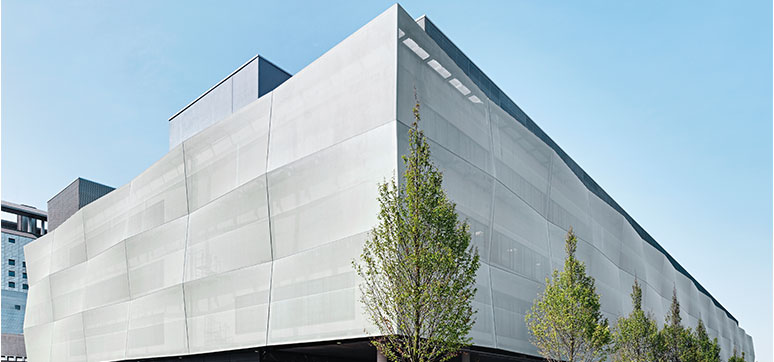
Kumaran too agrees that there has been tremendous growth in technology over the last two decades and interactive façades, green façades, and dynamic façades are a reality today. However availability, affordability, and constructability need to improve to make them usable across product typologies.
Energy Harvesting Façades
The next-gen façades should be able to generate and even store renewable energy. According to Ar. Zainuddin, energy harvesting façades would be the ideal solution, where façades should help the building to generate sufficient energy. This could ensure that the buildings of the future can stay off the pier grid and can truly be self-sustainable. However, these are still too expensive to be considered for projects in India in their current formats. We need to encourage better planning and design principles based on the natural resources and orientating the building as per ideal directions, he notes.
Advanced embedded photovoltaic cells, micro windmills, and heat filter membranes in façades will take care of more than 50 per cent of the energy needs of the buildings, predicts Ar. Bhole. He quotes an example: the light dam panels on façades would be used with two-way fiber optic cables to illuminate the dark interior of the buildings in the daytime and illuminate the façade in the night with the reverse flow of light thus resulting in a lot of saving.
Ar. Parekh defines energy harvesting as the process of collecting ambient energy from sources such as heat, wind, etc., which are typically wasted, and converting them into electric energy. This process is also known as power scavenging or energy scavenging. The use of Double Skin
Adaptive Façades
The conventional envelope is based on static designs that do not possess the flexibility to adapt and react to changing conditions. However, both the building’s environment and the occupants’ wishes are changing over time. This reason for the advancement in adaptive façades. The building envelope is no longer seen as just a shield, but as a surface that can control efficiently the energy balances. Adaptive façades add the fourth dimension of time – by implementing dynamic features in copper. Dynamic copper façades enable modern buildings to interact with their environment and can limit the use of artificial lighting and heating, regulate aeration, light, or transparency, and create unprecedented visual effects.
Ar. Vivek Gupta, Principal Architect, Arvind Vivek & Associates
Façade (DSF) is increasingly being used as a means to harvest wind energy, notes Parekh. The system employs a series of small-scale wind turbines strategically located within the Cavity Wall to capture wind energy and use it towards the built environment.
Ar. Patel and Ar. Gupta observes that photovoltaic façades have the potential to generate clean energy to full capacity, which is also CO2 emission-free and plentiful. While photovoltaic installations for energy generation over rooftops of buildings are limited, building façades that occupy large vertical surfaces of the structure can produce more energy, making the building self-sustained to energy requirements.
In any standard G+4 Architectural Built form, the area of the façades is almost four times the area of the roof. If the whole available area of such a building was used for solar panels, the total annual electricity harvested would be three times that of the roof, observes Ar. Gupta. Furthermore, the use of Building Integrated Photovoltaics (BIPV) proposes interesting opportunities by replacing conventional building materials while creating harmonious architecture by blending into building design. The overall use of such façades not only brings us closer to designing a net-zero building but reduces the commercial pressure off the investors, explains Ar. Gupta.
Role of CAD, Software Technologies & AI in Designing & Building Futuristic Façades
Computers and software are helping us design more and more interesting façades that we couldn’t do in the past – such as parametric façades. “I am fond of using computer-aided technology which helps us design intelligent façade that react to the external climatic conditions,” says Ar. Karl Wadia. Ar. Krupa Zubin too agrees with the increased use of CAD for all aspects of building design, mainly structural and efficient environmental planning. “The façades can also be optimized by running various programs on the building models. This helps in the generation of the most cost-effective and energy-efficient solution for projects,” she says.
Solar-Powered Façades
Solar energy farms typically need large open land, while photovoltaic panels placed on the building roofs are rarely able to generate energy to meet full demand. A unique design opportunity has been initiated at the Hanwa Tower in the middle of Seoul. The renovation will be one of the world’s largest solar-powered façades — cladding the entire tower in photovoltaic cells and an illuminated LED system that will become an eye-catching animated display at night. The buildings will receive a new system of windows and shading to increase natural daylight inside the building and reduce energy costs. The LEDs will flash through scenes found in nature to emphasize its environmental friendliness
The recent progress in computation technology and the availability of diverse software, plug-ins, and coding platforms have provided the tools to identify problems and develop unique design solutions, points out Ar. Parekh. Emerging technologies using complex algorithms and AI will assist designers in understanding complex design challenges so as to offer comprehensive distinctive resolutions.
“We use plugins like a honeybee in Rhino to interact with software like Days and Radiance to calculate the light, glare, and artificial lighting requirements, and Energy Plus to calculate the solar heat gain. The interactive simulation, right from the form-finding methods to shop drawings through the parametric software, gives flexibility to the extent that you can imagine, evaluate, rationalize and execute innovative designs with high-performance façades”, notes Ar. Bhole. The computational software generates parametric façades, including designing and executing drawings for CNC machines. Software like Generative Component in Ecosim, Dynamo in Revit, and Grasshopper in Rhino are powerful tools to achieve unimaginable forms, he adds.
Ar. Bhole uses Geometry Gym and Interface Plugin for Archicad in Rhino to connect computational parametric software with BIM (building information modeling). “We are going to witness the use of this technology going multiplefold in the near future,” says Ar. Bhole. Kumaran too agrees that software like Rhino and Grasshopper enable more complex form development, and detailed research and analysis. Parametric software can enable designing complex forms and solutions at rapid speed, based on defined parameters such as climatic needs, shading requirements, solar radiations, wind resistance, and more.
According to Ar. Parekh, CAD was a way of automating existing methods of production for speed and precision. Consequently, tools provided manoeuvrability. The “craft” of CAD will assist with complex site issues related to traffic flow, micro-climatic concerns, seismic abnormalities, and the resultant impact on façade behavioural patterns and will take building design towards a new dimension. These software tools will be vital for evaluating material deflection, building massing/form, and sway of shade and light. Software technologies will offer designers the opportunity to monitor site changes, and conflicts with building services, and allow integration with IBMS (Intelligent Building Management Systems). Technology will allow us to envision ‘futuristic kinetic façades’ using multi-faceted forms using diverse materials, textures, colours, etc. using real-time weather information, adds Parekh.

Ar. Patel believes that investing in technologies like BIM allows designers to distil options down to a set of criteria that meet the aesthetic ambitions of the project and its tactical requirements, ensuring that these are met with optimized environmental parameters. These tools also enable designers to explore the forms, in real-time and derive key insights into the thermal, daylight, and solar performance informing decisions pertaining to the building orientation, solar shading, glazing, etc, and also saving the cost. According to Ar. Patel, a strong basis to drive AI can be marked with the data fed by BIM applications. Not only façades but from materials to architectural/mechanical elements to every fitting, including the smallest screw- the data is saved and computed to inform anticipated design/construction glitches for seamlessness.
Architecture is dominated by software, from pre-concept to construction. This is doubly so with sustainability – only with the advent of whole building simulation and BIM, could energy modeling, computational fluid dynamics, and daylight analysis be rigorously forecasted, says Ar. Gupta. These predictive simulations provide the necessary data to determine everything from indoor comfort to energy cost savings to potential glare on computer screens. The emerging technology uses algorithms to generate every possible permutation of a design solution. The designer simply enters a set of parameters and then chooses the best outcome generated by the software. AI promises to save time in the design process, save material by creating the most efficient structures and save money by working out the most cost-effective way to manufacture them.
Advancement in Automation in Façades & Fenestration
The automation in façades can be primarily categorized into three sections – lighting, sun shading, and fire safety, explains Ar. Bhole. The entire façade lighting scheme can be controlled through a single automation controller to give imagery on the façade or highlight key elements of the façades. With new fixtures, it is possible to create multiple lighting schemes with minimum light pollution. Ar. Zainuddin too agrees to this. Through automation systems, one can control the heat gain, thus saving on the cooling load considerably. The National Building Code requires a certain percentage of the façade area openable for various user types of buildings. Most of the time, this becomes a hurdle in design flexibility. Automation can remove this constraint by adding openable windows and fresh air. All these systems can get activated along with the fire alarm connected with fire and smoke detection systems.
According to Ar. Wadia automation can be used in two ways: one is for extremely high-rise buildings where you have large size of windows and very often these windows are difficult to manually operate because of the sheer weight. The other area where we used an automated façade is for access by the fire department in the building, you can program certain aspects of the façade to work with BMS.
Ar. Parekh too observes that designers have become increasingly reliant on technology as a means to create “smart homes”. Computerized HVAC systems, home security, lighting systems, and virtual assistants using artificial intelligence, all controllable through a centralized hub. Automation continues to play a larger role to advocate cost efficiencies; to monitor automated glass tinting for responsiveness to dynamic climatic conditions, blind automation for privacy concerns, and even a safe façade cleaning automated mechanism.
Automation can monitor the heat extraction from a double-skin façade consisting of a single exterior layer of heat-strengthened or laminated safety glass, with exterior air inlets and outlet openings controlled with automatic throttling flaps. A second layer, the interior façade, consists of fixed or operable, double- or single-pane, casement, or hopper windows. The concept is similar to exterior shading systems – solar radiation loads are blocked before entering the building – but the heat absorbed by the between-pane shading system is released within the intermediate space and drawn off through the exterior skin by automated mechanical ventilated means.
There are façades, which can mechanically move to control daylight, climate, aesthetics, lighting, etc., using built-in sensors, says Kumaran. But they are still in the experimental stages. They need to be mainstreamed, across geographies and markets. The dynamic range of outdoor luminance and irradiance is orders of magnitude greater than the desired indoor range, says Ar. Gupta.
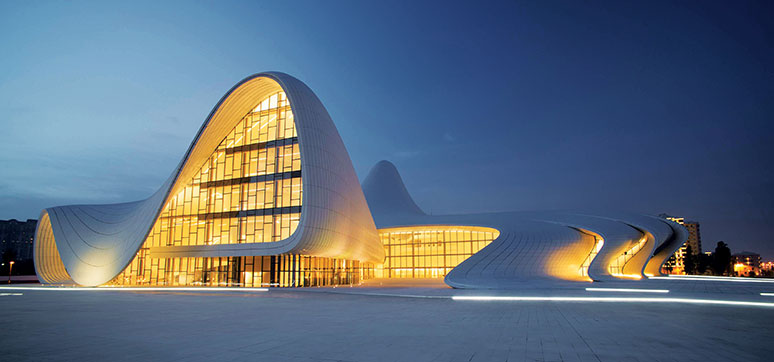
Ar. Patel states that structures can now be their own intelligent architectural statements, with possibilities to keep up and auto-upgrade with time! From accumulating data on the exterior environmental factors surrounding the building to programming it to create interior environments to suit the occupant’s needs – smart technology in building material has already made its break-in. Through such technologies, the interior environments can be adapted to impact and create ambient temperatures, manage humidity, color, density, and conditions of use through the entire span of the day. What remains to be seen is how concepts like Google Home extend to breathe into an entire building infrastructure with an ultimate sense of individualized performance adaptations.
Interactive Façades: Advantages & Disadvantages
With the smart façade technology and various software, the interactive simulations can give both performance and flexibility in design expression, says Ar. Bhole. The high-performance façades and glass can eliminate many climatic restrictions like the need for sun shading devices, darker shades of glass to reduce heat gain, increase visual light transmission, and fire safety needs, he explains. Further evolution should make the façades think, behave and perform. The advantages are many like improvement of visual experience from outside as well as from inside and sustainability.
But according to Ar. Zainuddin interactive façades are a bit too gimmicky for the Indian market and are more relevant within internal spaces. The skyline needs to be more conducive for a range of interactive façades, these are relevant for cities of developed countries, he opines.
Interactive façade connects and communicates with the users based on preferences and environmental conditions, says Ar. Kumaran.
The current philosophy is to design the building envelope with responsive, interactive systems, also often called “intelligent envelopes”, says Ar. Gupta. According to Ar. Gupta, building envelope systems should react sensibly to the changes in the exterior climate and adjust in solar gain, daylighting, heat loss, ventilation, and venting to the changing needs of the occupants and the building. The interactive façade concept is thus an effective starting point both to actively manage the changing `incident` climatic conditions and the occupant’s interior needs based on both changing tasks and variable preferences. This starts with better utilization of energy flows associated with daylighting and useful solar gain. It can also include wind and buoyancy-driven natural ventilation and building-integrated photovoltaic systems, (BIPV). Inevitably, these new functions potentially add complexity and cost to the envelope, both in hardware and in “process”. These systems will be widely used if their overall lifecycle benefits, measurable and perceived, exceed their costs and potential liabilities.
Latest Trends & Technologies in Façade Lighting
In the current times, says Ar. Bhole, architectural designs require lighting solutions that have good lighting performance as well as good quality that can minimize the cost and time needed for maintenance. Today, designers are not only making the structure innovative but are also using materials that are sustainable. Some of the latest variants are Dynamic LED lighting wherein programmable LED luminaires are used in a creative manner to enhance façades. Both colour-changing, as well as colour temperature-changing (warm white to cool white) products, are available. Being long-lasting, easy to install, and maintenance-free, LED luminaires have become a must-have for every lighting designer. Ar. Patel talks about an array of façade lighting solutions, including LED floodlights, Pixel/Point Lights, Interactive Video Sections, Underground LEDs, LED Linear Lights, LED Wall Washers, and more.
Ar. Parekh has no doubt that façade lighting adds glamour and beauty by highlighting the subtle features of the architecture, without impairing them. Recent advancements in façade lighting include the development of responsive external shading systems with built-in blinds and other powered solutions. The challenge for designers will be to be able to use these advancements without electricity. “Research on photochromic and thermochromic glass that naturally adapt to the environment has been ongoing, but I understand, it may not still be commercially viable”, says Ar. Parekh. According to Kumaran, colour accents, dynamic lighting, and programmed lighting are becoming more popular now. Ar. Patel says that architectural lighting solutions need to be planned to bring out the best in the building’s architectural details, making it stand out, expressive and communicative.
Architectural lighting solutions need to be planned to bring out the best in the building’s architectural details, making it stand out, express, and communicate. In terms of what’s been around within the domain is an array of façade lighting solutions that include LED floodlights, Pixel/ Point Lights, Interactive Video Sections, Underground LEDs, LED Linear Lights, LED Wall Washers and more.
Ar. Gupta adds that intelligent lighting is also becoming increasingly necessary for providing aesthetically elegant façades, and nocturnal landscapes as well as to be sensitive towards the creatures that are active at night, such as insects and migrating birds, and save resources. Façade lighting, besides being used as a marketing factor via media screens, is also seeing a rise in monumental façade lighting with the use of textile-based building materials.
Revolutionizing Future Material & Technology
Most of the current materials used for façades have certain wastage due to the difference in standard sizes of manufacturing and in the actual usages of the same. This wastage can range from 15 to 50 per cent sometimes, observes Ar. Bhole. Various resin-based products will dominate the cladding technologies. Resin with clay, and resin with stone particles, and the options are infinite. “If I have to say just one material, then glass-reinforced resin panels customized and manufactured to the final level of execution should be the next-gen material and self-cleaning façades is the need of the future”, says Ar. Bhole.
Ar. Zainuddin and Ar. Krupa Zubin clearly sees the need for better efficiencies in glass with larger sizes and less tinted variety of glass to truly experience the natural quality of the light around. They also look forward to self-maintaining façade systems.
Ar. Parekh is also eager to find self-cleaning claddings and finishes that can help improve notoriously challenging upkeep, protecting from dirt and smog. Self-cleaning technology is not only useful for the upkeep of large structures but can also be used for smaller buildings. This Nanotechnology is now used on claddings that are coated with a mixture of nanoparticles that allow the material to repel water, oil, and dirt. Besides, the obvious advantage of recurring costs and water savings, the generally dilapidated appearance of our urban spaces will be a great benefit for such emerging technologies.
Ar. Wadia wishes to see façades made out of waste material such as plastics, bottles, and others; but fire-resistant and endurable considering the life span of façade, i.e., about 25- 30 years. “It should be discounted by the Government and should be heavily promoted so that we can utilize waste in a good way in the construction industry,” he adds.
Ar. Kumaran wants to explore and experiment with Electronic Glasses and Photo-Voltaic Glasses on façade systems in India to achieve Net-Zero performance.
Ar. Patel wishes for material upgrades like pollution-absorbing bricks, self-healing concrete, translucent wood, sulfur-based concrete, etc., which have found cognizance in the western world of architecture and construction.
Ar. Gupta says, “I have been recently introduced to façade made from pollutants. These black façade panels are Made of Air – part of a Berlin-based manufacturer – are made from biochar”. Biochar is a waste product produced when trees are burned in pyrolysis kilns for energy; while 50 percent becomes heat energy, the rest becomes biochar.
We clearly have issues with the buildings we live in and how cities work. So we can work out a competent method that could radically improve the environment.
